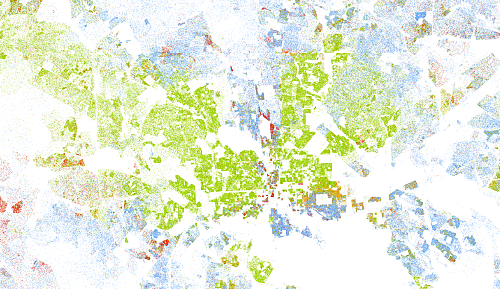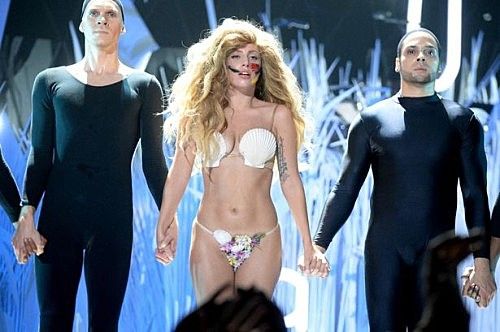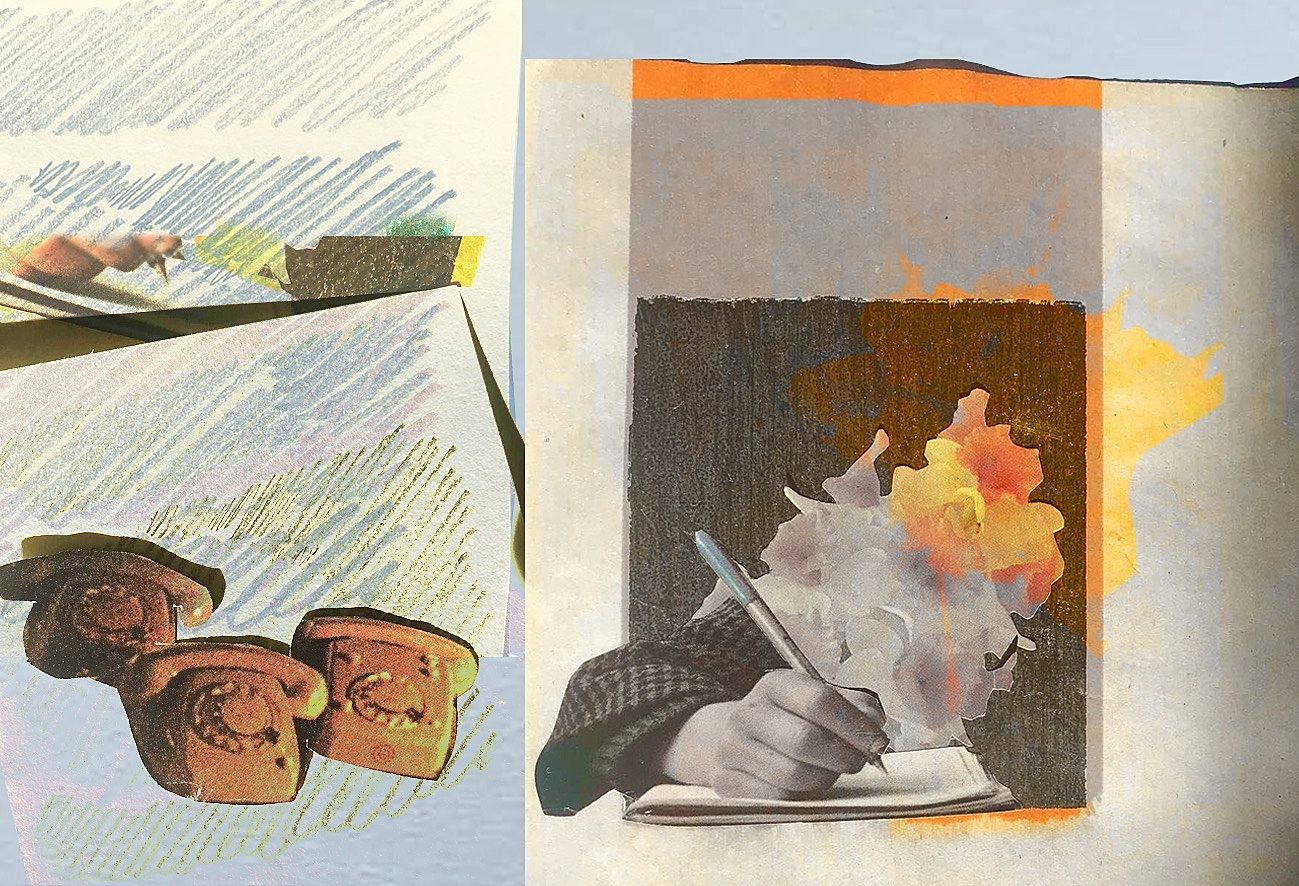Internet Histories | 2 September
This fortnight: The soul-sapping no-win spectacle of Syria, Buzzfeed as a diplomatic mouthpiece, Miley and Gaga at the VMAs, how Breaking Bad brings out the worst in certain fans, and racial dot maps of the United States.
Joe
[caption id="attachment_7945" align="aligncenter" width="500"] Photo Credit: NPR[/caption]
Like some sort of ghoulish anniversary bash, a decade since the Iraq War is being marked by UN weapons inspections, horrendous violence inflicted by a Middle Eastern strongman of former Western backing, and the threat of unilateral military action by the United States. Keen observers are right to say it's a very different matter, though. The American folly on the ground in Iraq was devastating for civilians and ultimately protracted, humiliating and expensive for the invading forces. Syria is its own country with its own ethnic and religious dynamics, and its own peculiar relationship with its allies (Russia, Iran). And there's precious little natural resource in it, nor the same cosy retaliatory benefit for 9/11. But maybe the real difference is the heaving, ambivalent exhaustion of hawks and pacifists alike; a feeling of hopelessness that the Coalition Of The Willing and its vocal opponents worldwide never stopped to succumb to.
If there were contested forms of idealism being thrown around in 2003 - "Team America: World Police"; "let the peaceful multilateral process work until it prevails"; "Peaceful Self-Determination"; "the power of anti-war activism" - this time the same quarters offer up muted resignation. When the Obama Administration has talked tough in taking military action against Bashir al-Assad, they've done so like it's a dress rehearsal. Every domestic equivocation has been tabled for the world to see, and it's very clear that the much-anticipated show of force from the US will be a somewhat-deadly keeping up of appearances, rather than any sort of co-ordinated effort to support those suffering (let alone topple Assad). Meanwhile, a UN solution slinks off glumly into the shadows - thanks to Russia and China's pre-determined veto, the failures of the Security Council feel more like a deja vu exercise in box-ticking than ever. Buzzfeed may want to juxtapose its "You Won't Believe What Vladimir Putin Gets Up To In These 36 Incredible LOL Photos" with its "let's get serious here for a moment, guys" attempts at documenting children dying in Syria and make some sort of line call.
In 2003, the lines were clearly drawn because so much of the cynical self-interest stacked up against the people who opposed the war. This time around, cynical self-interest stands in a sort of cloying solidarity beside those who have always taken a principled stance against the unilateral bombing of cities as a foreign policy. So you get Donald Rumsfeld climbing onto what must be a very low-slung high horse to castigate Obama for going into Syria without good cause, Tony Abbott's revolting observation that Syria "isn't as simple as goodies versus baddies...it's baddies versus baddies", and Ed Miliband's "oh shit, we won the vote" embrace of something called "hard-headed multilateralism". Strange bedfellows. And let's not get sanctimonious, because we don't even get to "stand for peace" - 100,000 lives down, there hasn't been any peace in Syria. It's possible there won't be for years.
Before the media really went into a frenzy in the past week, there'd been a lot of exceptional pieces on Syria in the last 18 months that are worth reading. Here's Slate expressing the sorry history of Western intervention in Syria's democratic business with a strip by comic artist Andy Warner. For the New York Times, Robert F. Worth wrote on the experience of Syria's Alawite minority. Al-Assad is Alawite, and they've enjoyed a privileged position until now - but Western accounts tend to broadly depict them all as an elite guard in the service of a tyrant, when what they largely are is scared and increasingly sectioned off. Though it's been buried under the use of chemical weapons right now, Foreign Policy have uncovered timely and haunting evidence of the US's complicity in Saddam Hussein's use of the safe very nasty stuff against Iran in the 1980s. And The Nation has gone behind rebel lines over a year into an agonising war of attrition, to find a sort of spiritual and moral abeyance, exquisitely articulated here:
He confesses that the rebels shouldn’t have launched their attack on Aleppo until they were sure they could take it, and his expression suddenly becomes gloomy. “The dream is over,” he says, and then promptly qualifies it: “Now, nobody cares about the future of Syria. All we want to do is finish this regime, no matter what the cost.” He asks me if I’ve heard about the death of his 5-year-old cousin Khalil. “It is things like this that make us hate, and the hatred in our hearts is growing,” Molham says. “I worry that one day it will be bigger than our dreams.” It’s only when he sits cross-legged at the front of the large schoolroom and delivers a speech full of earthy humor that I realize he’s taken Ayham’s place as battalion commander.
As a bonus: in February 2011,Vogue ran a glowing hagiography of Bashir al-Assad and his English-born wife, Asma. "A Rose In The Desert" was the fruit of a $5,000-a-month lobbying contract between the Syrian government and US lobbying firm Brown Lloyd James - its admirers included the late Paul Holmes, who appeared to have used it as the only reference point in his bizarre epigram on Syria in this infamous column. Anyway, Vogue panicked and pulled the piece, but you can still find it here.
And an appropriate segueway to lay into Buzzfeed some more without totally moving away from the Middle East: here's their recent contribution to the regional dialogue, with the sort of headline you might expect: "Threats Facing Israel, Explained In One (Sort Of Terrifying) Map". Ta for the parentheses. The infographic is sponsored by a community contributor, "israelinusa". That's the Israel Embassy. Buzzfeed's willingness to take big money and run official lines has been documented elsewhere, but the real concern is the way this huge omnivorous hub of the Bad Internet presents its political content and its stolen cat GIFs with a sort of semi-detachment, a shrug of "oh yeah, so this what politics is like" for the young and well-heeled and bored middle class.
Finally, another horrible share-bait website makes a horrible mistake and gives a horrible apology: here's Upworthy saying 'sorry' for a bogus science report in the most infantile way I could have imagined.
Kyle
Breaking Bad catalogues some of the more terrible ways to demonstrate power. Of course there is violence, money, and drugs, but there is also the softer — but no less terrible — coercion through the exploitation of friendship and familial ties. Walter White, the antihero protagonist, usually gets his way through incessant protestations that he is a good man who murders and extorts simply to provide for his family.
Walt’s wife, Skyler (played adeptly by Anna Gunn), has borne the brunt of his malice. He has lied to her, physically and mentally abused her, and attempted to rape her. Walt, in many respects, is evil; Skyler is one of his principal victims. This is central to the TV series.
You wouldn’t be able to tell from the fan base of the show. Gunn, in a quietly angry piece, explains the misogynistic invective to which Skyler and even Gunn herself have been subjected:
A typical online post complained that Skyler was a “shrieking, hypocritical harpy” and didn’t “deserve the great life she has.”
“I have never hated a TV-show character as much as I hate her,” one poster wrote. The consensus among the haters was clear: Skyler was a ball-and-chain, a drag, a shrew, an “annoying bitch wife.”
As Gunn notes, this sexist response to TV wives who are victims of abuse is not unique to Breaking Bad – look at Betty Draper and Carmela Soprano - and the deification of Don and Tony alike. She asks a couple of searching questions of these fans which hit right at the heart of the issue:
Could it be that they can’t stand a woman who won’t suffer silently or “stand by her man”? That they despise her because she won’t back down or give up?
*
Miley Cyrus is on a fairly standard pop trajectory: start off as a (usually blonde) teen Disney starlet, make loads of money and become ubiquitous, then ditch the virginal image for something a bit raunchier. It happened with Britney, it happened with Christina, and it’s happening again with Miley.
At MTV’s Video Music Awards last week, Cyrus continued along this trajectory, with a show involving a peach-coloured latex outfit, a lot of grinding onto Robin Thicke, and a few crotch grabs. Nothing, really, that people who have seen a music video in the last ten years should be surprised by.
But Cyrus continued with another, more unfortunate trend of hers: appropriating black culture and black bodies. In the past, she’s said she wants her record to have a “black sound”, that she wants to be more “urban”, and that she loves “hood music”. She uses the bodies of black people as accessories in her new music video. She appropriates twerking, a black dance move. And during her VMA performance, she followed that racist trajectory by spanking and tonguing the asses of her black back-up dancers.
The media has been saturated with terrible think-pieces about how Cyrus’s lack of clothing reinforces “raunch culture”, about her tattoos, her hair, and her twerking. But you can ignore all that, because Tressie McMillian Cottom has written a forceful and penetrating essay which is the only thing that anyone should read on the topic of Miley’s VMA performance.
Cyrus acts out her faux bisexual performance for the white male gaze against a backdrop of dark, fat black female bodies and not slightly more normative cafe au lait slim bodies because the juxtaposition of her sexuality with theirs is meant to highlight Cyrus, not challenge her supremacy. Consider it the racialized pop culture version of a bride insisting that all of her bridesmaids be hideously clothed as to enhance the bride’s supremacy on her wedding day.
Only, rather than an ugly dress, fat black female bodies are wedded to their flesh. We cannot take it off when we desire the spotlight for ourselves or when we’d rather not be in the spotlight at all.
*
Auckland recently banned beggars who are deemed to be “intimidating”, “causing a nuisance”, or “causing an unreasonable interference with the convenience of another person” from its streets, following trends to discourage asking fellow human beings for their spare change in hotbeds of cultural intrigue like Wellington and South Carolina.
Unemployment is rife and income inequality has been steadily rising in New Zealand over the past two decades. Our tax, welfare, and employment policies punish the poor and vulnerable, rather than helping people find robust, long-term employment and supporting them when they cannot. It is no wonder there are people begging on the streets. This bylaw should be an outrage.
It will have a disproportionate racial impact. Māori are more likely to be homeless than white people, and will likely be found “intimidating” more often than their white counterparts. Poverty, gentrification, and social housing policy has created de facto racial and economic segregation of Auckland suburbs already – this bylaw will have a similar effect on the CBD.
Dustin Cable catalogues a similar type of de facto segregation in a set of wonderful and depressing maps. His “racial dot map” of the United States depicts a landscape of sprawling blues (white people) with pockets of green (black people), red (Asian people), orange (Hispanic people), and brown (other races and multiracial people).
Here is Baltimore:
And here is Los Angeles:
Integration won’t happen simply because begging is allowed. But the begging ban bylaw presents another abhorrent step down the road of victimisation, inequality, and injustice. Hopefully we can find a way to take a step back.
James
What with #twerkgate, Justin’s doddery N-Sync reunion and that guy from One Direction introducing the sepulchral boy-band charms of Joy Division to a generation of tweens, Lady Gaga picked a challenging time for a comeback. She opened the VMA’s with what was effectively Lady Gaga’s tribute to the work of the pop-star Lady Gaga, the best moments of which are GIF’d here. While I’m excited about the music, I’m also psyched about the return of people on the internet who take Lady Gaga far too seriously (of which I am probably one). Of the things that first got me into Gaga was this chem-trail soaked conspiracy theory from the Vigilant Citizen:
While masses of young people imitate Gaga’s gestures, her act is part of a bigger system that incorporates many other stars with the same symbolism. She is creative and a gifted song writer. But at the end of the day, the “Lady Gaga” persona is a Fame Monster, doing everything required to be an international superstar, including incorporating in her act the symbolism of the elite, making her an Illuminati puppet.
The Vigilant Citizen sees the all-seeing eye in everything. For an academic-level discussion of Lady Gaga that doesn’t fixate on the occult, there is the very serious Gaga Stigmata. The site has two editors, one of whom has a Comparative Literature PhD and is working on a book about Nabokov. It also takes submissions, some of which are good, some of which are indescribable:
I watched the “Bad Romance” video the other day, the video that got me into Gaga. I wanted to see how it aged. So much seems to have happened in pop since 2009, the first time I jacked off to that video and cried because my artistic career was over and I now belonged to an Italian woman I’d never met.
Pop music is often seen as a disposable, low form of art - so, crywanks aside, it’s reassuring to see it treated seriously. While some pop music is definitely a manufactured and calculated product, there are plenty of geniuses working in the medium. One of them, Neil Tennant from the Pet Shop Boys, was famously a music writer before he was a pop star. He coined the term “imperial phase” to describe a moment when the Pet Shop Boys could do no wrong - and it’s the subject of one of my favourite columns about music, from Tom Ewing’s Poptimist in 2010.
I don't just love the phrase because I love the Pet Shop Boys. It popped into my head the day after Lady Gaga's "Telephone" video came out, and overloaded every filter I had. My networks of rock writers on Tumblr and Twitter were talking about it. But so were my networks of office workers. And so were serious newspapers, and entertainment channels, and all the chatter was reflected in the views for the video and sales of the song. Gaga was owning the moment. She is in her imperial phase.
Not that Ewing knew it at the time of writing in May 2010, but Gaga’s imperial phase came to an end with “Telephone”. Since then, she has done what she does to ever diminishing returns; not necessarily due to her product being demonstrably worse, but because her time has been and gone.
Neil Tennant knew when the Pet Shop Boys' imperial phase was over: the group returned with "Domino Dancing", an introverts' take on freestyle which performed only respectably. Their best albums were still to come: as he said in an interview last year, "what's interesting is what you do after."
While Gaga hasn’t had time to sit on a therapist’s couch and theorise about her career, her fans still comprehensively deconstruct her videos within days of them coming out.
“Applause” presents images from throughout Gaga’s journey — her as an 18-year-old, hoping to hit it big, her Fame, The Fame Monster, and Born This Way eras — and we can see now how various images from earlier in her career have gone on to become defining moments in both her career and pop culture at large. The young Gaga we see dancing and writhing on a mattress in her apartment in the Lower East Side probably couldn’t predict that those same moves would later end up in music videos in her career as a pop star.
I like her new song, and I look forward to her new album coming out. ARTPOP could be an overblown, pretentious and hilarious thesis statement from someone who has lost touch with why people liked her in the first place - or it could be intelligent, provocative and define the genre in the way that “Bad Romance” and “The Fame Monster” did. I’m willing to give her the benefit of the doubt, because intelligent pop music is something that Miley could learn a thing or two about.







